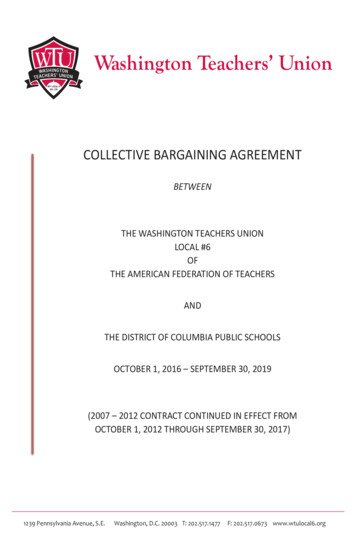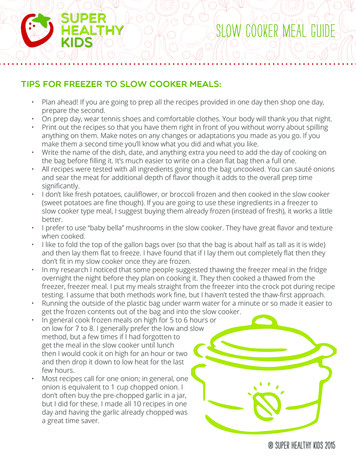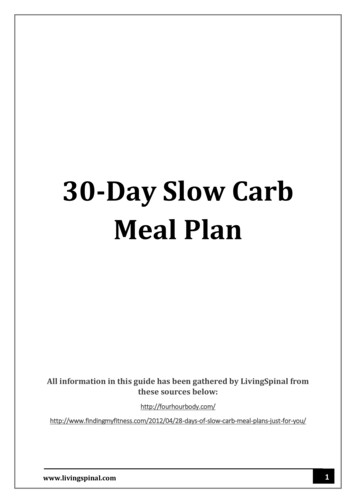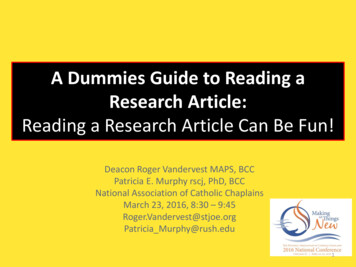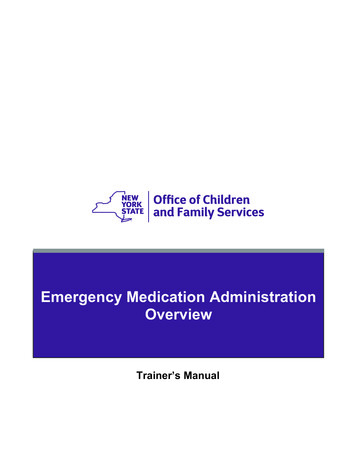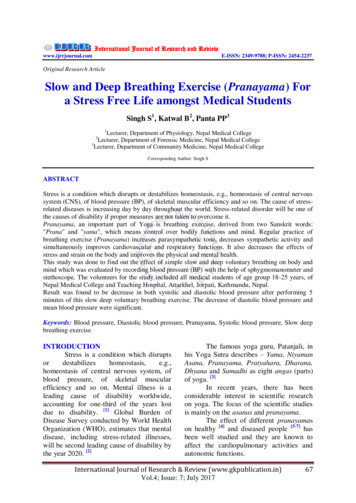
Transcription
International Journal of Research and Reviewwww.ijrrjournal.comE-ISSN: 2349-9788; P-ISSN: 2454-2237Original Research ArticleSlow and Deep Breathing Exercise (Pranayama) Fora Stress Free Life amongst Medical StudentsSingh S1, Katwal B2, Panta PP31Lecturer, Department of Physiology, Nepal Medical CollegeLecturer, Department of Forensic Medicine, Nepal Medical College3Lecturer, Department of Community Medicine, Nepal Medical College2Corresponding Author: Singh SABSTRACTStress is a condition which disrupts or destabilizes homeostasis, e.g., homeostasis of central nervoussystem (CNS), of blood pressure (BP), of skeletal muscular efficiency and so on. The cause of stressrelated diseases is increasing day by day throughout the world. Stress-related disorder will be one ofthe causes of disability if proper measures are not taken to overcome it.Pranayama, an important part of Yoga is breathing exercise, derived from two Sanskrit words:"Prana" and "yama", which means control over bodily functions and mind. Regular practice ofbreathing exercise (Pranayama) increases parasympathetic tone, decreases sympathetic activity andsimultaneously improves cardiovascular and respiratory functions. It also decreases the effects ofstress and strain on the body and improves the physical and mental health.This study was done to find out the effect of simple slow and deep voluntary breathing on body andmind which was evaluated by recording blood pressure (BP) with the help of sphygmomanometer andstethoscope. The volunteers for the study included all medical students of age group 18-25 years, ofNepal Medical College and Teaching Hospital, Attarkhel, Jorpati, Kathmandu, Nepal.Result was found to be decrease in both systolic and diastolic blood pressure after performing 5minutes of this slow deep voluntary breathing exercise. The decrease of diastolic blood pressure andmean blood pressure were significant.Keywords: Blood pressure, Diastolic blood pressure, Pranayama, Systolic blood pressure, Slow deepbreathing exerciseINTRODUCTIONStress is a condition which disruptsordestabilizeshomeostasis,e.g.,homeostasis of central nervous system, ofblood pressure, of skeletal muscularefficiency and so on. Mental illness is aleading cause of disability worldwide,accounting for one-third of the years lostdue to disability. [1] Global Burden ofDisease Survey conducted by World HealthOrganization (WHO), estimates that mentaldisease, including stress-related illnesses,will be second leading cause of disability bythe year 2020. [2]The famous yoga guru, Patanjali, inhis Yoga Sutra describes – Yama, NiyamanAsana, Pranayama, Pratyahara, Dharana,Dhyana and Samadhi as eight angas (parts)of yoga. [3]In recent years, there has beenconsiderable interest in scientific researchon yoga. The focus of the scientific studiesis mainly on the asanas and pranayama.The effect of different pranayamason healthy [4] and diseased people [5-7] hasbeen well studied and they are known toaffect the cardiopulmonary activities andautonomic functions.International Journal of Research & Review (www.gkpublication.in)Vol.4; Issue: 7; July 201767
Singh S et al. Slow and Deep Breathing Exercise (Pranayama) For a Stress Free Life amongst Medical StudentsPranayama is derived from twoSanskrit words – prana (life) and yama(control). Pranayama or the control ofprana or the life force yields control overbodily functions and the mind. [3]It is known that the regular practiceof breathing exercise (pranayama) whileincreasing parasympathetic tone decreasessympathetic activity and simultaneouslyimproves cardiovascular and respiratoryfunctions. It also decreases the effect ofstress and strain on the body and improvesphysical and mental health. [8-10]The present batch of medicalstudents will grow up as standard andqualified doctors that will contribute to thedevelopment of society and the nation. Thestudents are under immense stress with theirstudies and competition. So, it would bebetter if they could be properly equippedwith techniques to overcome tremendousstress later in the life, especially throughsimple and effective exercise like slow anddeep voluntary breathing.Leaving the yoga-philosophy asideand being more confined to the modernmedical physiology only, the present studywas carried out to find out the effect of slowand deep voluntary breathing (withoutbreath holding , maximum possible deepinspiration followed by maximum possibledeep expiration) on body and mind.The objective of this study was toassess effect of slow and deep voluntarybreathing exercise on systolic and diastolicblood pressure (SBP and DBP).MATERIALS AND METHODSThe study was conducted inDepartment of Physiology, NMCTH,Attarkhel, Jorpati, Kathmandu, Nepal. Thevolunteers were MBBS students of NMCTHwho were healthy and non-smoker. Samplesize of this study consisted of 100 malestudents. After explaining the objective ofthe study, consent was taken fromvolunteers, verbally.Following 5 minutes of rest, abaseline blood pressure (BP) was recordedinsittingposition.Mercurysphygmomanometer and stethoscope wereused to measure blood pressure. [11]The breathing technique was demonstratedto them and the same they practiced.They were directed to sit in an easyand steady posture (Sukhasan) with head,neck and trunk erect and in straight linekeeping the body still while practicing slowdeep inspiration followed by slow deepexpiration for 5 minutes (approximately 4times per minute, i.e., 20 times in 5minutes). They were told to take slow deepinspiration i.e., to inhale slowly up tomaximum through both nostrils. This wasfollowed by slow expiration i.e., to exhaleslowly to the maximum through bothnostrils.Thebreathingexercisewasconducted in cool, well-ventilated room (2025⁰C). After 5 minutes of this breathingpractice their blood pressure was recordedagain in the aforesaid manner using thesame instruments.All the collected data were compiledand entered in Microsoft Excel and thenanalyzed by SPSS version 16 by usingstudent t test.Those respondents who were havingproblem of cardiovascular disease werereferred to the concerned department formanagement.RESULTSSlow and deep voluntary breathingfor 5 minutes caused decrease in bloodpressure in most of the volunteers.In volunteers the systolic bloodpressure (SBP) decreased from 111.28 mmof Hg to 109.20 mm of Hg, and the diastolicblood pressure (DBP) decreased from 72.74mm of Hg to 67.66 mm of Hg, after doingslow and deep voluntary breathing exercisefor 5 minutes.Mean blood pressure (MBP) involunteers decreased from 84.30 mm of Hgto 80.12 mm of Hg, after slow and deepvoluntary breathing exercise for 5 minutes.The change in systolic bloodpressure (SBP), diastolic blood pressure(DBP), Mean blood pressure (MBP) beforeInternational Journal of Research & Review (www.gkpublication.in)Vol.4; Issue: 7; July 201768
Singh S et al. Slow and Deep Breathing Exercise (Pranayama) For a Stress Free Life amongst Medical Studentsand after slow deep breathing exercise wasfound to be statistically significant.Table: Change in systolic and diastolic blood pressure (SBP andDBP) and mean pressure after performing slow and deep voluntarybreathing exercise for 5 minutes.Mean SDp valueSBP before111.28 10.43 0.00slow deep breathing exerciseSBP after109.20 9.75slow deep breathing exerciseDBP before72.74 6.370.00slow deep breathing exerciseDBP after67.66 6.82slow deep breathing exerciseMBP before84.30 7.390.00slow deep breathing exerciseMBP after80.12 7.38slow deep breathing exerciseDISCUSSIONIn Hering-Breuer inflation reflex,inflation of the lung to a volume greaterthan tidal volume stimulates stretchreceptors of lungs and causes reflexexpiration.During inflation or inspiration abovetidal volume, the slow adapting stretchreceptors present in lungs get stimulated andproduce inhibitory impulses.In slow and deep voluntarybreathing exercise, as in Hering-Breuerinflation reflex, the inflation is deep (abovetidal volume). So stretch receptors of lungsare stimulated which increases frequencyand duration of inhibitory neural impulses[12]which is shown by study of Jerath R,Edry JW, Barnes VA, Jerath V.These inhibitory impulses controlautonomic functions for example systemicvascular resistance [13] which is concludedby study done by Schelegle E, GreenSchelegle J.This inhibitory current regulatesexcitability of nervous tissue, [14] (as shownby Cuttle MF et al study), and is known toelicit synchronization of neural elements.According to studies done bySiegelbaum R, Robinson S. and Roberts L,Greene J; inhibitory current synchronizesrhythmic cellular activity between thecardiorespiratory center [15] in brainstem andthe central nervous system. [16]Newberg A, Iversen J. and Lutz A,Greischar LL, Rawlings NB et al in theirstudies concluded that mus is responsible for inducingparasympathetic response [18] during slowand deep voluntary breathing exercise.In a study done by Pramanik T, Sharma HO,Mishra S et al it was found that slow paceBhastrika pranayama influences the bloodpressure through enhanced activation ofparasympathetic system. [19]Hainsworth R's study found thatinflation of lungs decreases systemicvascular resistance [20] and DBP dependsupon peripheral vascular resistance. Thisresponse is initiated by pulmonary stretchreceptors. When there is inflation of lungs,pulmonary stretch receptors decreasesystemic vascular resistance. Study done byDaly M, De B, Robinson BH, states that thepulmonarystretchreceptorscausewithdrawal of sympathetic tone in skeletalmuscle blood vessels which results inwidespread vasodilatations and it leads todecrease in peripheral vascular resistance[21]and hence decrease in the DBP and meanblood pressure, which was also the resultseen in volunteers of this study.Bernardi L, Porta C, Spicuzza L. intheir study found that slow breathingsignificantly increases sensitivity ofbaroreceptors. During slow breathing thereis relative increase in vagal activity andreduction in both systolic blood pressure(SBP) and diastolic blood pressure (DBP).[22]Thus, slow and deep voluntarybreathing exercise for 5 minutes causesreduction in both systolic and diastolicblood pressure (BP) and hence mean bloodpressure is also reduced.Limitations:Due to small sample size and timelimitation, the finding could not begeneralized in a large population.CONCLUSIONSlow and deep voluntary breathingexercise for 5 minutes shows improvementin balancing autonomic nervous systemInternational Journal of Research & Review (www.gkpublication.in)Vol.4; Issue: 7; July 201769
Singh S et al. Slow and Deep Breathing Exercise (Pranayama) For a Stress Free Life amongst Medical c system.Hence, slow and deep voluntarybreathing exercise for 5 minutes, whichinvolves respiratory rate approximately 4times per minute, can be practiced forreducing stress and mental relaxation indaily life, which can help the medicalstudents to study effectively.A simple method for a stress free lifeis slow and deep voluntary breathingexercise daily for about 5 minutes.ACKNOWLEDGEMENTWe thank the students of MBBS of NepalMedical College and Teaching Hospital(NMCTH) for their participation in the study.Conflict of interest: None7.8.9.10.REFERENCES1. Begg, S., Vos, T., Barker, B.,Stevenson, C., Stanley, L., & Lopez, A.D. (2007). The burden of disease andinjury in Australia 2003. PHE 82.Canberra: AIHW.2. Murray CJL, Lopez AD. The globalburden of disease: a comprehensiveassessment of mortality and disabilityfrom diseases, injuries and risk factorsin 1990 and projected to 2020. Reporton behalf of the WHO and World Bank,Cambridge: Harvard University Press;1996.3. Yoga-Sutra of Patanjali. Translated bySaugata Bhaduri. D.K Printworld (P)Ltd. new Delhi.2000.4. Subbalakshmi N.K., Saxena S.K.,Urmimala, D'Souza Urban J.A.Immediate effect of NadishodhanPranayama on some selected parametersof cardiovascular, pulmonary and higherfunctions of brain. Thai J PhysiologicalSciences 2005; 18: 10-16.5. Cooper S, Oborne J, newton S, HarrisonV, Thompson Coon J, Lewis S andTattersfield A. Effect of two breathingexercises (Buteyko and pranayama) inasthma: a randomized controlled trial.Thorax 2003; 54: 64-75.6. Dhungel K U, Malhotra V, Sarkar D,Prajapati R. Effect of alternate nostrilbreathing exercise on cardio-respiratory11.12.13.14.15.16.functions. Nepal Med Coll J 2008;10:25-27.Ravindra P.N., Madanmohan, P.Pavithran. Effect of pranayam (yogicbreathing) and shavasan (relaxationtraining) on the frequency of benignventricular ectopics in two patients withpalpitations. Int J Cardiol 2006;108:124-125.Bhargava R, Gogate MG, MascarenhasJF. Autonomic responses to breathholding and its variations followingpranayama. Indian J Physiol Pharmacol1988; 42: 257-64.Telles S, Nagarathna R, Nagendra HR.Breathing through a particular nostrilcan alter metabolism and autonomicactivities. Indian J Physiol Pharmacol1994; 38: 133-7.Mohan M, Saravanane C, Surange SG,Thombre DP, Chakrabarthy AS. Effectof yoga type breathing on heart rate andcardiac axis of normal subjects. Indian JPhysiol Pharmacol 1986; 30: 334-40.Pramanik T, Shrestha S, Ghosh A.Apparently less value of blood pressureamong healthy people: Is the cuff widthresponsible? J Prev Med Hyg 2007; 48:83-4.Jerath R, Edry JW, Barnes VA, JerathV. Physiology of long pranayamicbreathing: Neural, respiratory elementsmay provide a mechanism that explainshow slow deep breathing shifts theautonomic nervous system. MedHypotheses 2006; 67: 566-71.Schelegle E, Green Schelegle J. Anoverview of the anatomy andphysiologyofslowlyadaptingpulmonary stretch receptors. RespirPhysiol 2001; 125: 17–31.Cuttle MF, Rusznák Z, Wong AY et ated current at anexcitatory synaptic terminal in the ratauditory brainstem. J Physiol 2001;534: 733-44.SiegelbaumR,RobinsonS.Hyperpolarization activated cationcurrent:Frommoleculestophysiological function. Annu RevPhysiol 2003; 65: tedcurrent:Acharacterization of subicular neurons inInternational Journal of Research & Review (www.gkpublication.in)Vol.4; Issue: 7; July 201770
Singh S et al. Slow and Deep Breathing Exercise (Pranayama) For a Stress Free Life amongst Medical Studentsbrain slices from socially andindividually housed rats. Brain Res2005;1040: 1-13.17. Newberg A, Iversen J. The neural basisof the complex mental task ofmeditation:Neurotransmitterandneurochemical considerations. MedHypotheses 2003; 61: 282-91.18. Lutz A, Greischar LL, Rawlings NB etal. Long-term meditators self-inducehigh amplitude gamma synchronyduring mental practice. Proc Natl AcadSci USA 2004; 101:1669-73.19. Pramanik T, Sharma HO, Mishra S,Prajapati R, Singh S. Immediate effectof slow pace Bhastrika pranayama onblood pressure and heart rate. J AlterComplement Med 2009; 15: 293-5.20. Hainsworth R. Circulatory responsesfrom lung inflation in anaesthetizeddogs. Amer J Physiol 1974; 226: 24755.21. Daly M, De B, Robinson BH. Ananalysis of the reflex systemicvasodilator response elicited by lunginflation in dog. J Physiol London 1968;195: 387-406.22. Bernardi L, Porta C, Spicuzza L. Slowbreathing increases arterial baroreflexsensitivity in patients with chronic heartfailure. Circulation 2002; 105: 143-5.How to cite this article: Singh S, Katwal B, Panta PP. Slow and deep breathing exercise(pranayama) for a stress free life amongst medical students. International Journal of Research andReview. 2017; 4(7):67-71.******International Journal of Research & Review (www.gkpublication.in)Vol.4; Issue: 7; July 201771
Pranayama is derived from two Sanskrit words – prana (life) and yama (control). Pranayama or the control of prana or the life force yields control over bodily functions and the mind. [3] It is known that the regular practice of breathing exercise (pranayama


